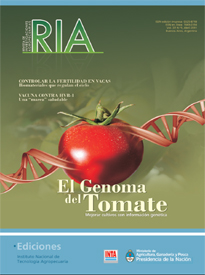Ver ítem
- xmlui.general.dspace_homeCentros Regionales y EEAsCentro Regional MisionesEEA Cerro AzulArtículos científicosxmlui.ArtifactBrowser.ItemViewer.trail
- Inicio
- Centros Regionales y EEAs
- Centro Regional Misiones
- EEA Cerro Azul
- Artículos científicos
- Ver ítem
Contenido de catequinas en cultivares argentinos de té (Camellia sinensis), elaborados como té negro
Resumen
El presente proyecto tuvo como objetivo determinar el contenido de materia seca de las siguientes catequinas, epigalocatequina-3-galato (EGCG), epigalocatequina (EGC), epicatequina (EC), catequina (C) y catequina galato (CG), en los cultivares de té CH 14 INTA, CH 112 INTA, CH 318 INTA, CH 410 INTA y CH 732 INTA elaborados como té negro, durante tres épocas de zafra. Se empleó un sistema de extracción acuosa y la determinación de los compuestos se efectuó
[ver mas...]
El presente proyecto tuvo como objetivo determinar el contenido de materia seca de las siguientes catequinas, epigalocatequina-3-galato (EGCG), epigalocatequina (EGC), epicatequina (EC), catequina (C) y catequina galato (CG), en los cultivares de té CH 14 INTA, CH 112 INTA, CH 318 INTA, CH 410 INTA y CH 732 INTA elaborados como té negro, durante tres épocas de zafra. Se empleó un sistema de extracción acuosa y la determinación de los compuestos se efectuó por cromatografía líquida de alta resolución (HPLC), con elución isocrática. Los contenidos de catequinas se analizaron por análisis de variancia (P<0,05), se estudiaron las diferencias entre cultivares y la población control, épocas e interacciones. Se compararon las medias entre cultivares y la población control por medio de la prueba de Comparación Múltiple (P<0,05). Los resultados obtenidos permiten establecer que el contenido total promedio de todas las catequinas analizadas, alcanzó a 1,53 de materia seca (%). EGCG fue la catequina con más alta concentración, alcanzado un promedio 1,10% ± 0,13, no registrando diferencias significativas entre cultivares. EGC alcanzó un segundo nivel con una concentración de 0,16%±0,03. Para EC, C y CG las concentraciones fueron de 0,16% ± 0,06; 0,06%± 0,016 y 0,04%± 0,009, respectivamente. Entre los cultivares se presentaron diferencias significativas respecto al resto, el cultivar CH 410 INTA presento los mayores contenidos de EGCG, EGC, EC y C, con 1,30; 0,19; 0,29 y 0,11% respectivamente; para CG el cultivar CH 318 INTA presenta el mayor contenido con 0,068%. Entre las épocas de zafra, se registraron diferencias significativas, con los mayores contenidos promedio al inicio de zafra para todas las catequinas analizadas. Sus contenidos para CGCG, EGC, EC, C y CG, fueron 1,47; 0,22; 0,27; 0,13 y 0,063% respectivamente.
[Cerrar]
The present project was conducted with the objective of evaluation the content of the following catechins,
epigallocatechin-3-gallate (EGCG), epigalocatechin (EGC), epicatechin (EC), catechin (C) and catechin
gallate (CG), in the tea cultivar CH 14 INTA, CH 112 INTA, CH 318 INTA, CH 410 INTA and CH 732 INTA
elaborated as black tea, during three harvest times. A system of water extraction was used and the determination was made by high performance
[ver mas...]
The present project was conducted with the objective of evaluation the content of the following catechins,
epigallocatechin-3-gallate (EGCG), epigalocatechin (EGC), epicatechin (EC), catechin (C) and catechin
gallate (CG), in the tea cultivar CH 14 INTA, CH 112 INTA, CH 318 INTA, CH 410 INTA and CH 732 INTA
elaborated as black tea, during three harvest times. A system of water extraction was used and the determination was made by high performance liquid chromatography (HPLC), with isocratic elution.
The catechin contents were analyzed by analisis of variance (P < 0.05), the differences were studied
among cultivars and the population control, times and interactions. The means were compared among cultivars and the population control by Multiple Range Test (P < 0.05). The obtained results allow to establish the following conclusions. The total average content of all the analyzed catechins, reaching at 1.53 of dry matter (%). EGCG was the catechins with higher concentration, reaching at an average of 1.10% ± 0.13, not registering significant differences among cultivars. EGC reached a second level with a concentration of 0.16%±0.03. For EC, C and CG the concentrations were 0.16% ± 0.06; 0.06%± 0.016 and 0.04%± 0.009, respectively. Among the cultivars they presented significant differences, cultivar CH 410 INTA present the biggest contents in EGCG, EGC, EC and C, with 1.30; 0.19; 0.29 and 0.11% respectively; for CG cultivar CH 318 INTA presents the biggest content with 0.068%. For the harvest times, they registered significant differences, with the biggest contents average to the beginning for all the analyzed catechins. Their contents for CGCG, EGC, EC, C and CG, were 1.47; 0.22; 0.27; 0.13 and 0.063% respectively.
[Cerrar]

Autor
Fuente
RIA 37 (1) : 37-45 (abril 2011)
Fecha
2011-04
Editorial
Gerencia de Comunicación e Imagen Institucional, DNA SICC, INTA
ISSN
0325-8718
1669-2314
1669-2314
Formato
pdf
Tipo de documento
artículo
Palabras Claves
Derechos de acceso
Abierto
 Excepto donde se diga explicitamente, este item se publica bajo la siguiente descripción: Creative Commons Attribution-NonCommercial-ShareAlike 2.5 Unported (CC BY-NC-SA 2.5)
Excepto donde se diga explicitamente, este item se publica bajo la siguiente descripción: Creative Commons Attribution-NonCommercial-ShareAlike 2.5 Unported (CC BY-NC-SA 2.5)


